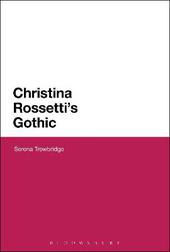
|
Christina Rossetti's Gothic
Hardback
Main Details
| Title |
Christina Rossetti's Gothic
|
| Authors and Contributors |
By (author) Dr Serena Trowbridge
|
| Physical Properties |
| Format:Hardback | | Pages:224 | | Dimensions(mm): Height 234,Width 156 |
|
| Category/Genre | Literary studies - c 1800 to c 1900
Literary studies - poetry and poets |
|---|
| ISBN/Barcode |
9781441114433
|
| Classifications | Dewey:821.8 |
|---|
| Audience | | Undergraduate | | Postgraduate, Research & Scholarly | |
|---|
|
Publishing Details |
| Publisher |
Bloomsbury Publishing Plc
|
| Imprint |
Bloomsbury Academic USA
|
| Publication Date |
1 August 2013 |
| Publication Country |
United States
|
Description
The poetry of Christina Rossetti is often described as 'gothic' and yet this term has rarely been examined in the specific case of Rossetti's work. Based on new readings of the full range of her writings, from 'Goblin Market' to the devotional poems and prose works, this book explores Rossetti's use of Gothic forms and images to consider her as a Gothic writer. Christina Rossetti's Gothic analyses the poet's use of the grotesque and the spectral and the Christian roots and Pre-Raphaelite influences of Rossetti's deployment of Gothic tropes.
Author Biography
Serena Trowbridge is Lecturer in English at Birmingham City University, UK.
Reviews[Trowbridge] resists the tendency to read Rossetti through a biographical lens, or to reclaim her to a feminist poetics that requires the omission of her devotional works. Instead, gothic becomes a framework for understanding Rossetti's poetry, in the context of her literary influences and Tractarian faith ... [an] insightful monograph. -- Susan Civale * Times Literary Supplement * This monograph succeeds in offering a genuinely fresh perspective on Christina Rossetti's work, making a persuasive case for viewing her as a Gothic writer . . . through a mix of careful close reading and wide-ranging contextual and theoretical research. -- Gregory Tate, University of Surrey * The Pre-Raphaelite Society * Trowbridge's book adds a tremendous amount simply in opening up the Gothic as an area of study for Rossetti. The connections she draws are persuasively established, clearly elaborated, and reframe not only Rossetti's works but their religious heritage. Built on excellent research into Rossetti's reading habits and inclinations from youth to maturity, as well as the aesthetic theories and critical attitudes that are likely to have influenced her writing, this study offers serious and fruitful engagements with a number of important works and figures from Rossetti's time to the present. -- Heather McAlpine, University of the Fraser Valley * Journal of Victorian Culture *
|